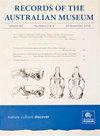A new genus and two new species of Caprellidae (Crustacea: Amphipoda) from mesophotic and deep-sea waters of Australia
IF 0.8
4区 生物学
Q4 ZOOLOGY
引用次数: 0
Abstract
Caprellids from mesophotic and deep-sea waters from Australia have been scarcely studied. A new genus Pseudoliropus gen. nov., and two new species Pseudoliropus keablei and Pseudoprotella australiensis sp. nov. are described based on material collected from 56 to 1125 m deep during surveys on board the vessels RV Sprightly (1973), FRV Kapala (1977–1986) and RV Southern Surveyor (2005) along the coast of the Northern Territory, Queensland, New South Wales, Victoria and Tasmania. Pseudoliropus is superficially very close to Liropus but can be readily distinguished by the absence of a mandibular molar (present in Liropus) and 2-articulate mandibular palp (3-articulate in Liropus). Pseudoprotella australiensis can be differentiated from all the remaining species of Pseudoprotella mainly on the basis of the unique body ornamentation (acute projection on the head, pereonites with abundant tiny tubercles scattered over the surface, and rows of lateral tubercles on the proximal end of pereonites 2–4). Further collections in deep ecosystems are mandatory to properly understand global amphipod diversity in Australian waters. Records of the Australian Museum a peer-reviewed open-access journal published by the Australian Museum, Sydney communicating knowledge derived from our collections ISSN 0067-1975 (print), 2201-4349 (online)标题澳大利亚中深水甲壳纲片足目一新属二新种
来自澳大利亚中生和深海水域的Caprellides几乎没有被研究。根据RV Sprigly(1973)、FRV Kapala(1977–1986)和RV Southern Surveyor(2005)在北领地、昆士兰州、新南威尔士州、维多利亚州和塔斯马尼亚州海岸进行调查期间从56至1125m深处收集的材料,描述了一个新属Pseudoliropus gen.nov.和两个新物种Pseudoli ropus keablei和Pseudoprotella australiensis sp.nov。假Liropus表面上非常接近Liropus,但可以很容易地通过缺失下颌磨牙(Liropus中存在)和2-关节下颌须(Liropus3-关节)来区分。澳大利亚假变形菌主要根据其独特的身体装饰(头部尖锐突起,表面散布着大量微小结节的多年生植物,以及2-4号多年生植物近端的一排排侧结节)与假变形菌的所有剩余物种区分开来。为了正确了解澳大利亚水域的全球两栖动物多样性,必须在深层生态系统中进行进一步的采集。《澳大利亚博物馆记录》,一本由悉尼澳大利亚博物馆出版的同行评审开放获取期刊,交流我们收藏的知识ISSN 0067-1975(印刷版),2201-4349(在线)
本文章由计算机程序翻译,如有差异,请以英文原文为准。
求助全文
约1分钟内获得全文
求助全文
来源期刊
CiteScore
0.90
自引率
0.00%
发文量
9
审稿时长
>12 weeks
期刊介绍:
Records of the Australian Museum, volume 62 was published in 2010, volume 63 in 2011. Monographic works of particular significance are published irregularly as Records of the Australian Museum, Supplements (ISSN 0812-7387).

 求助内容:
求助内容: 应助结果提醒方式:
应助结果提醒方式:


